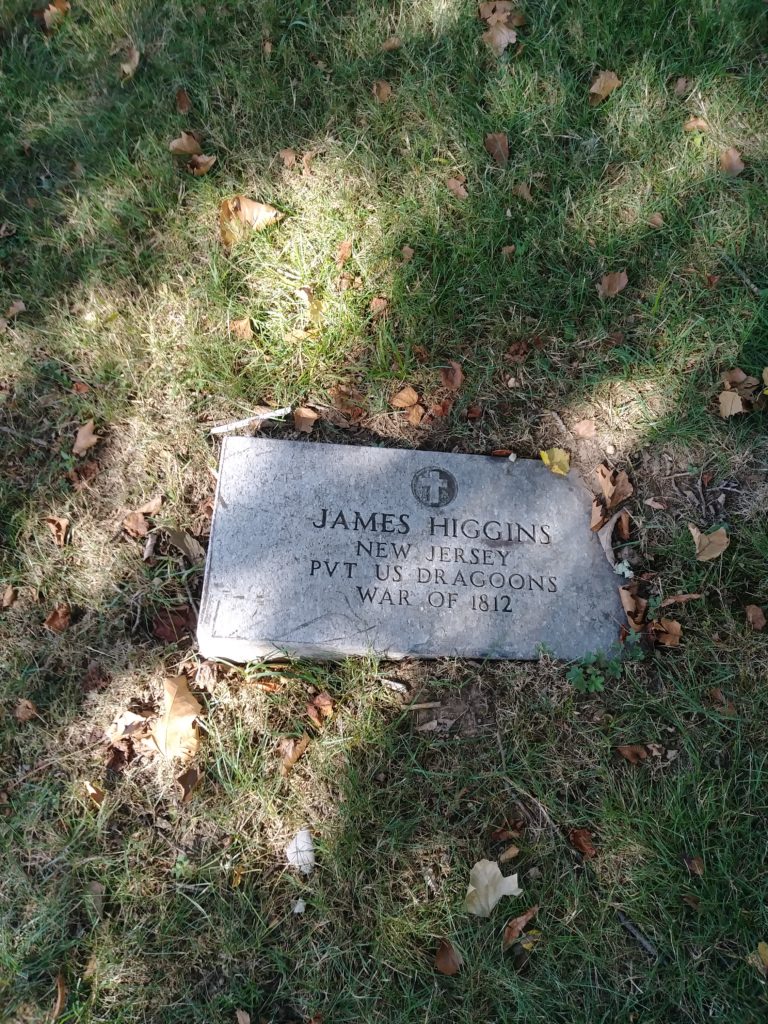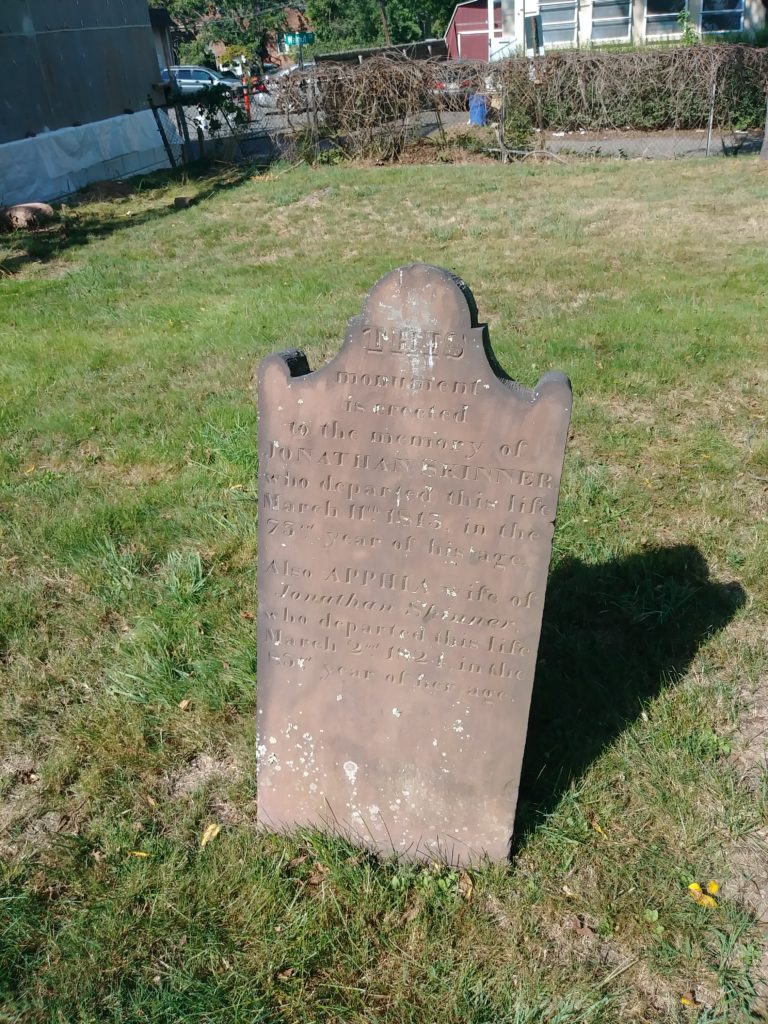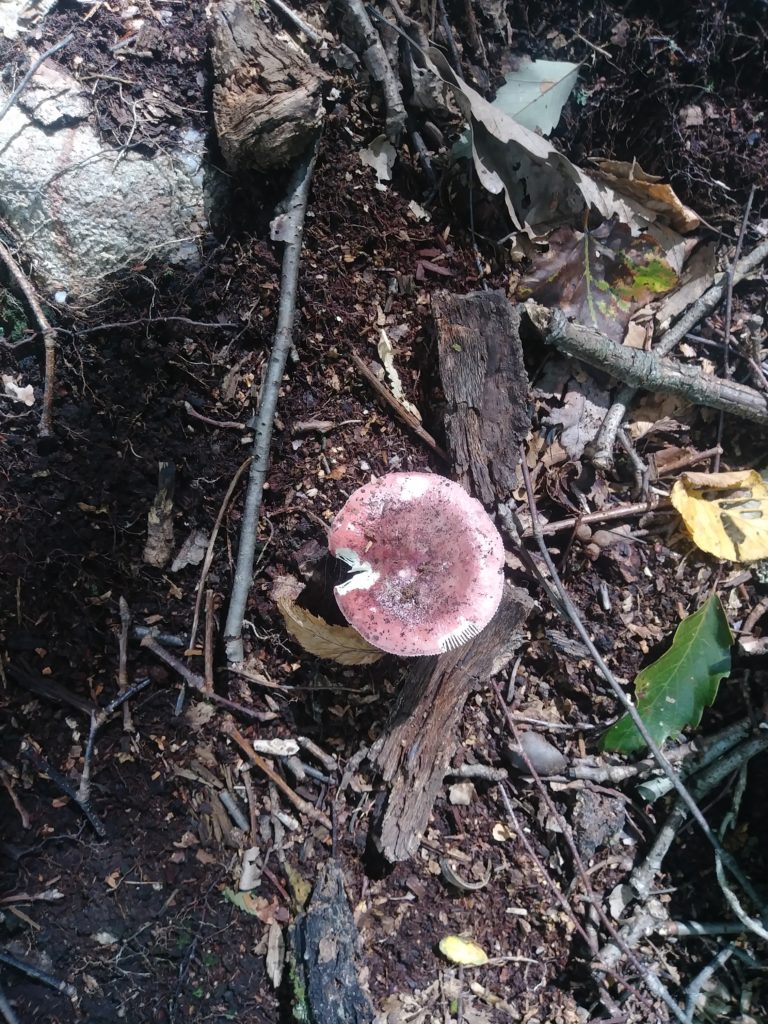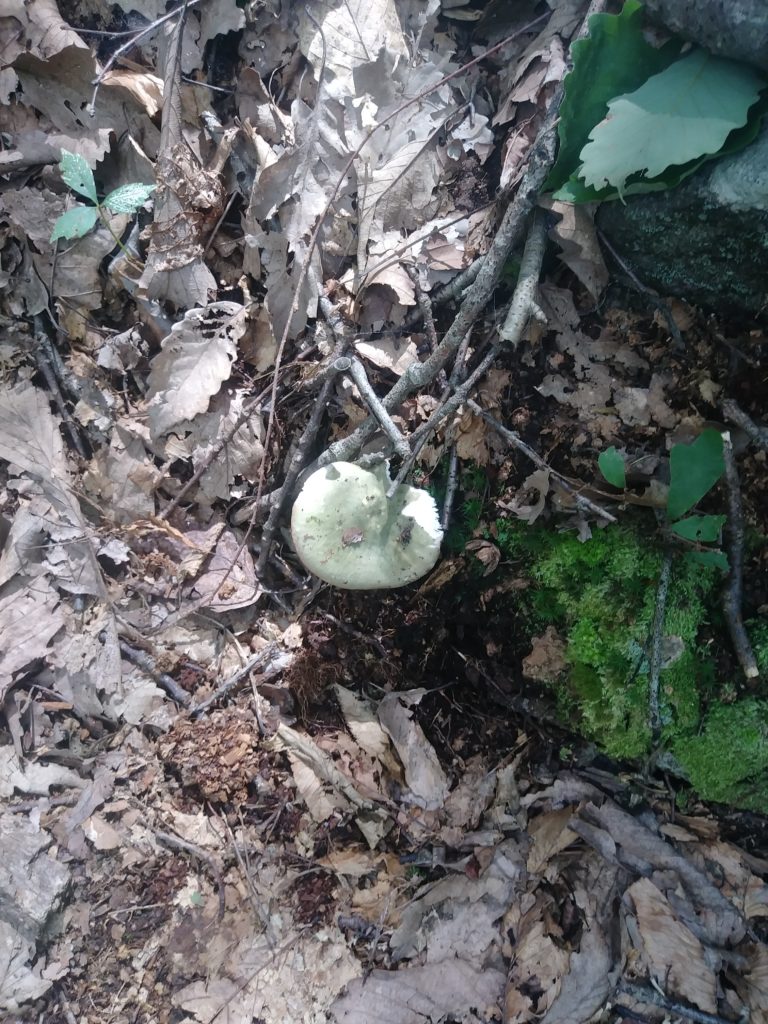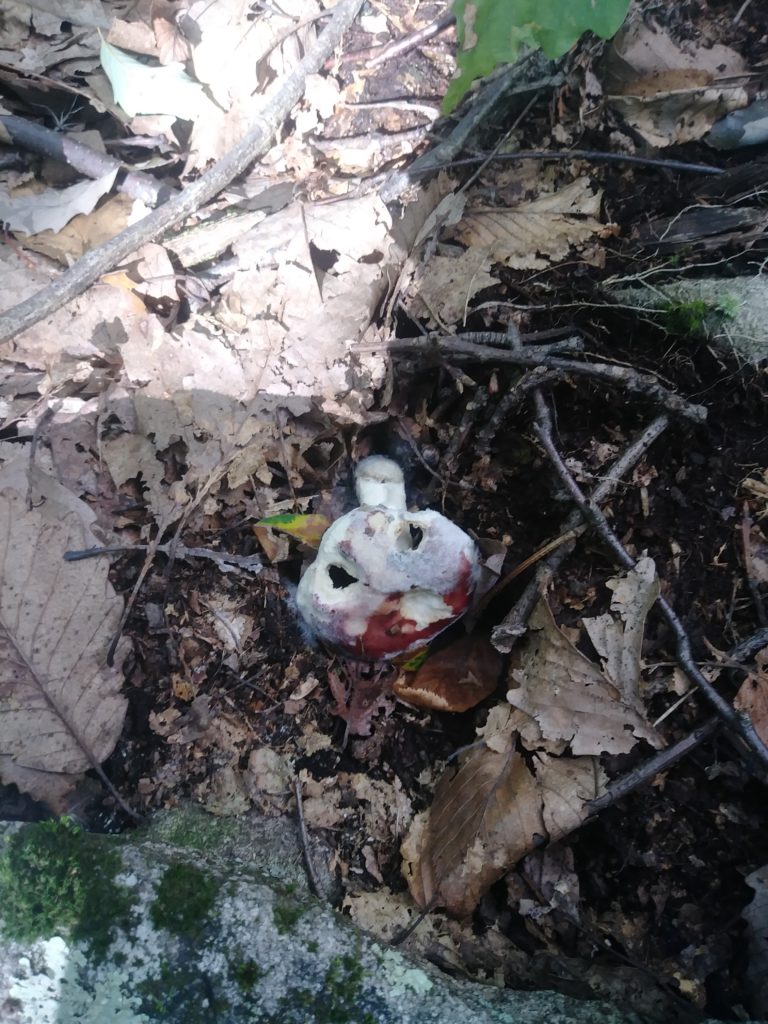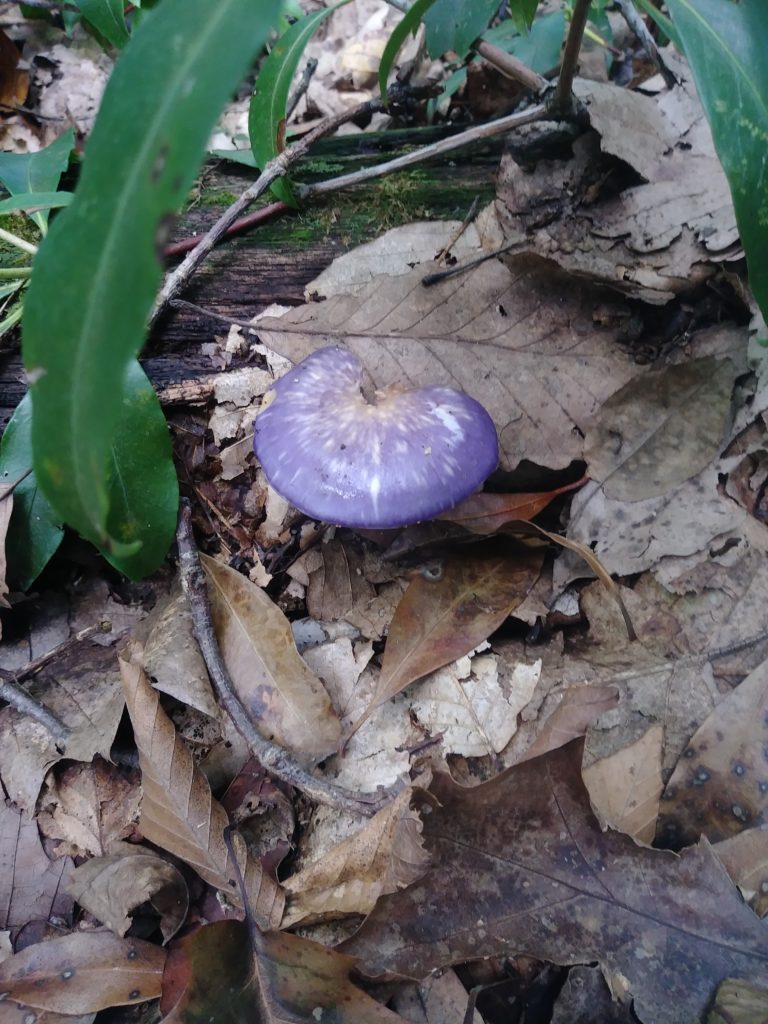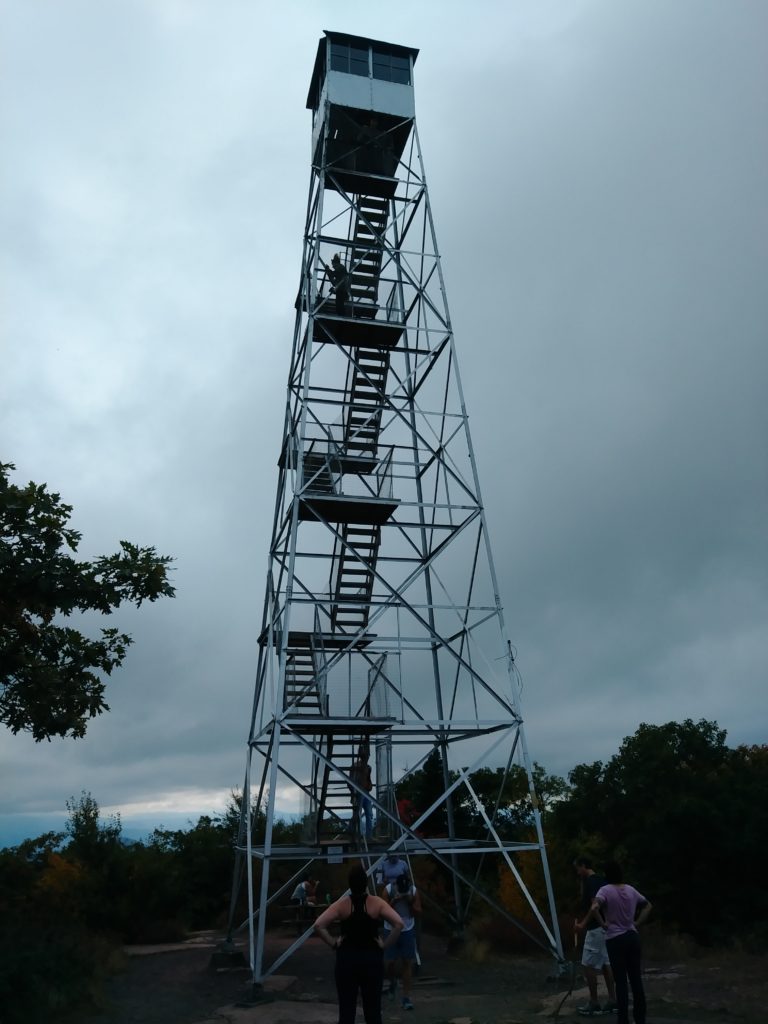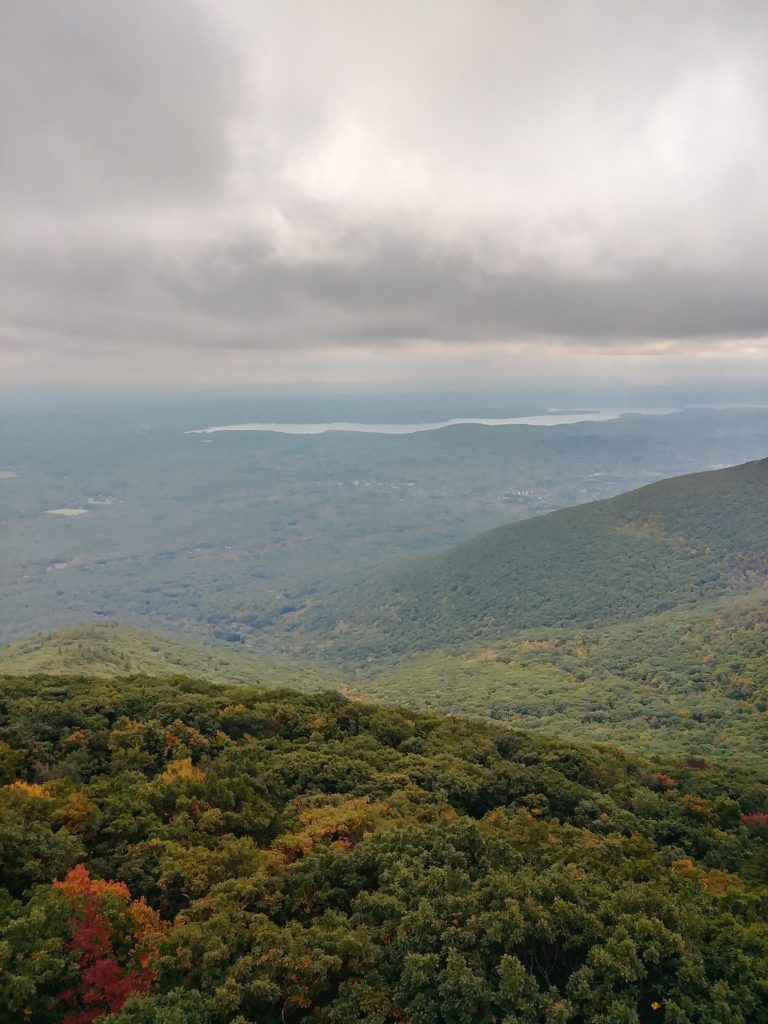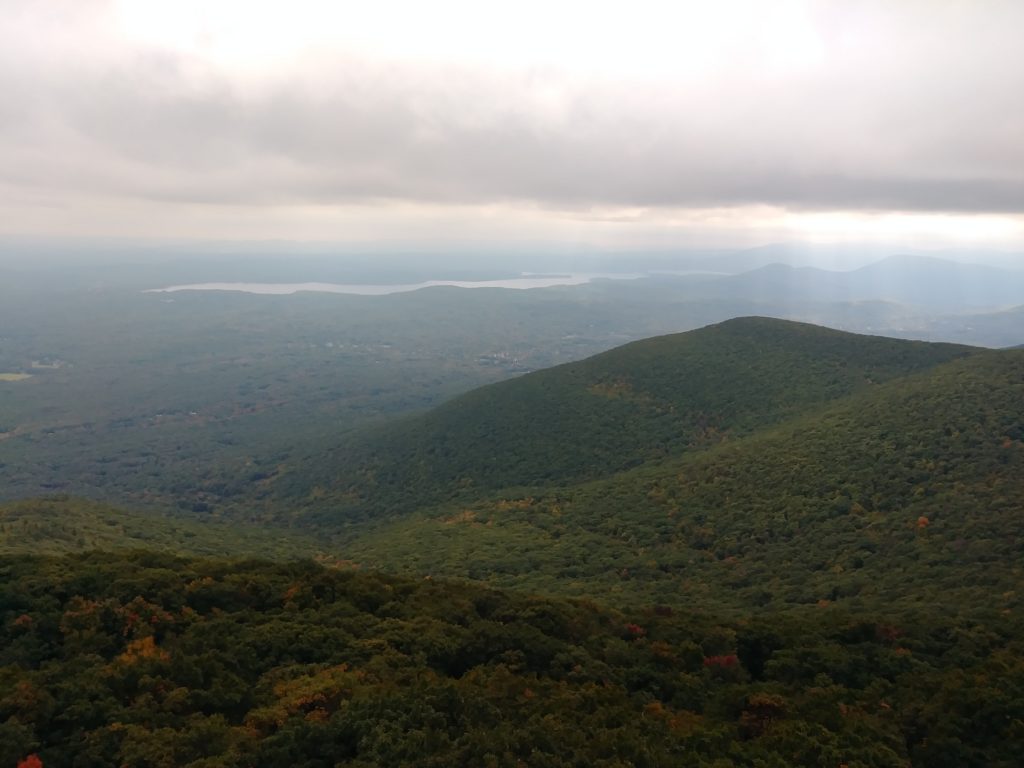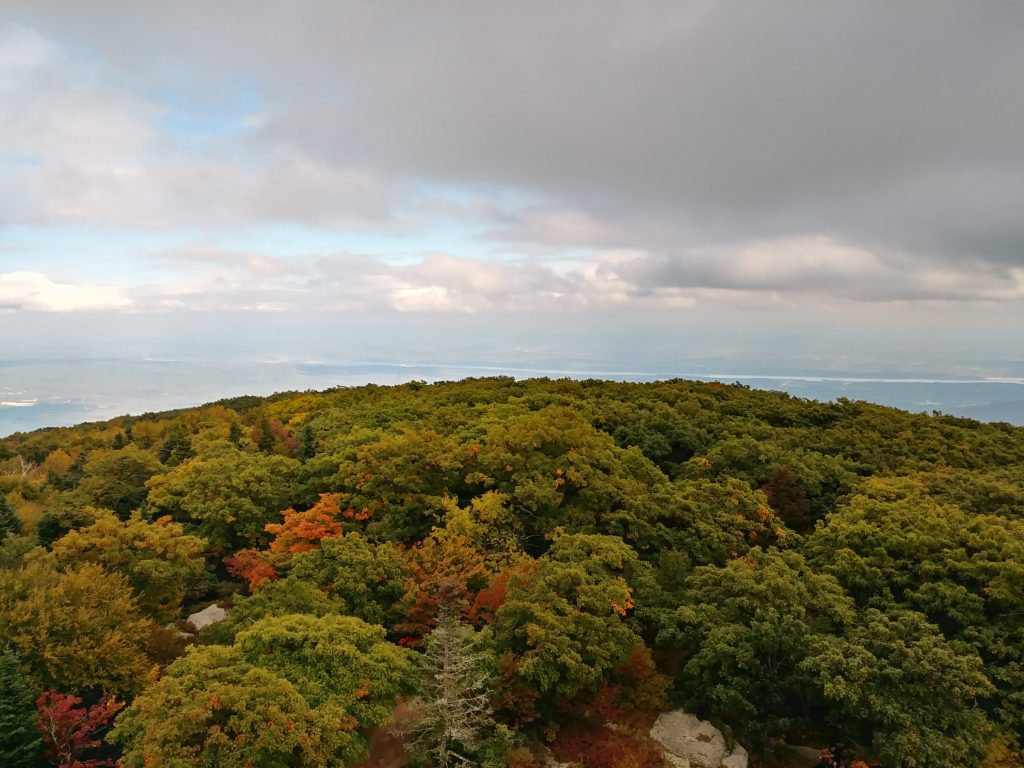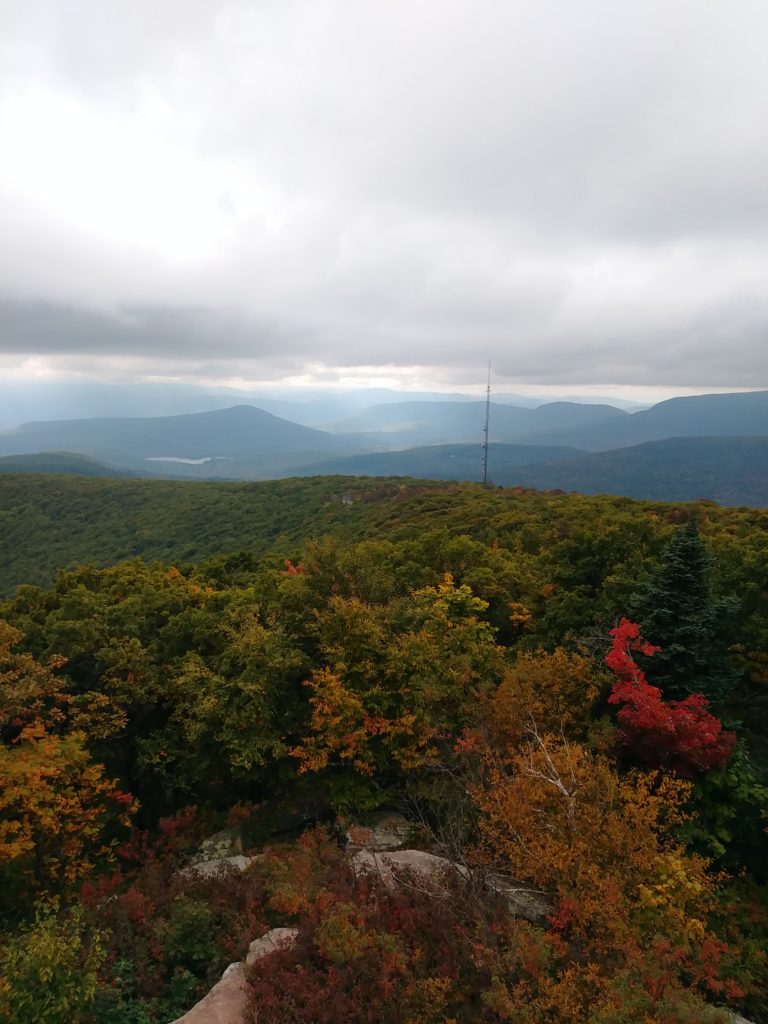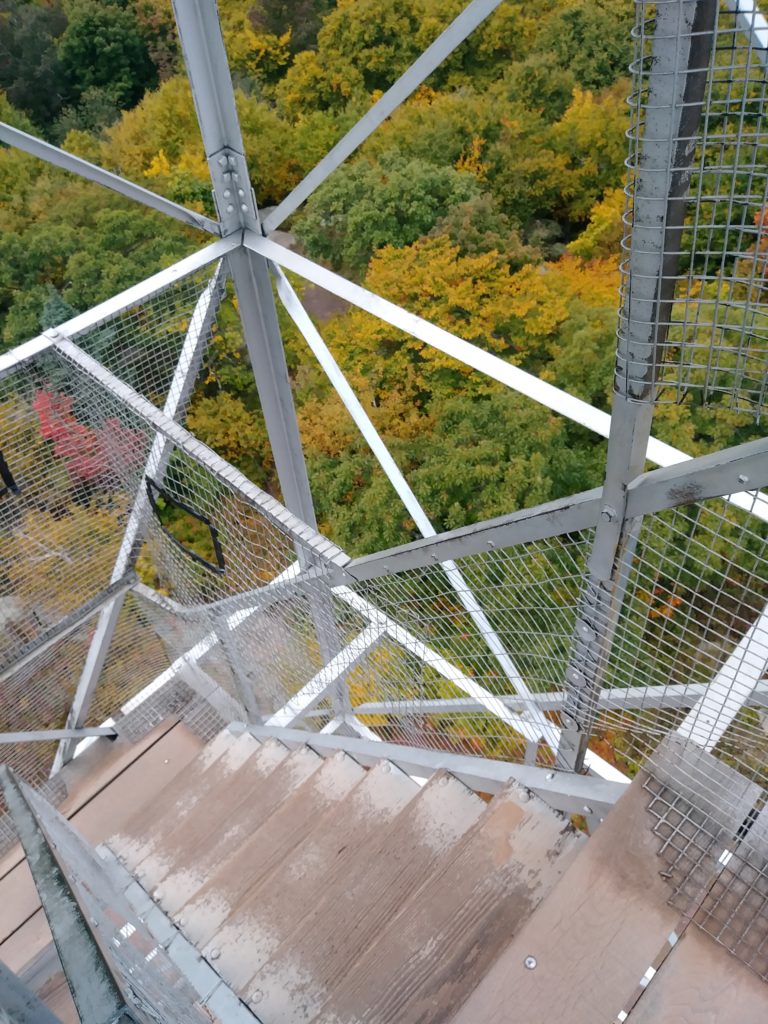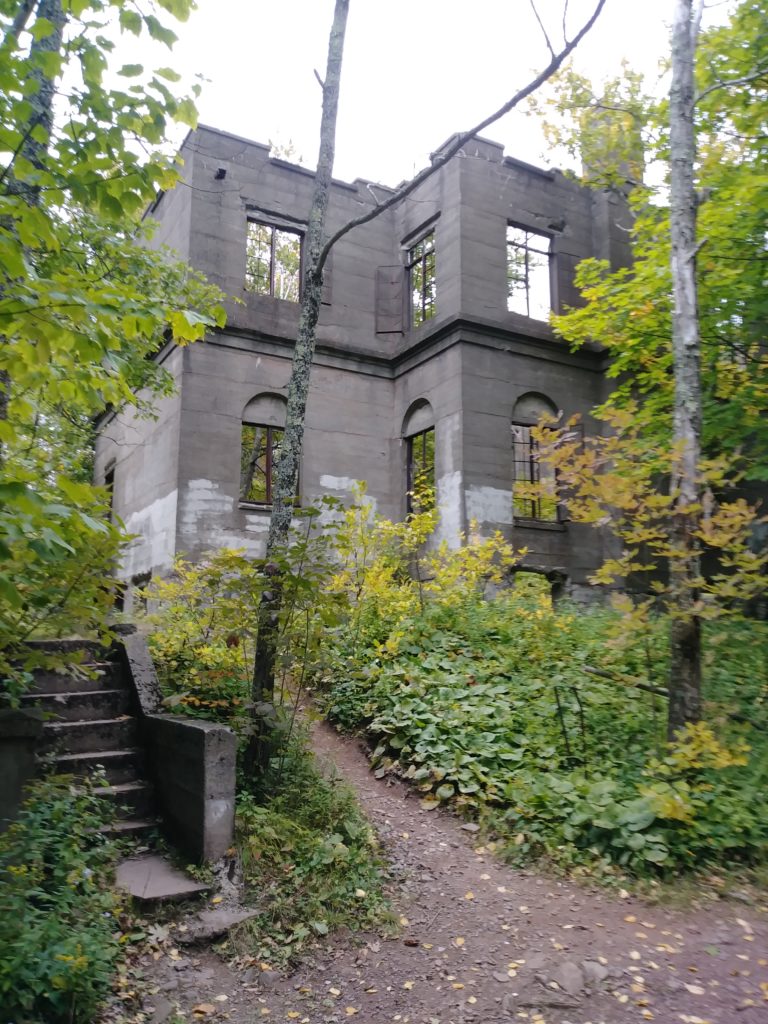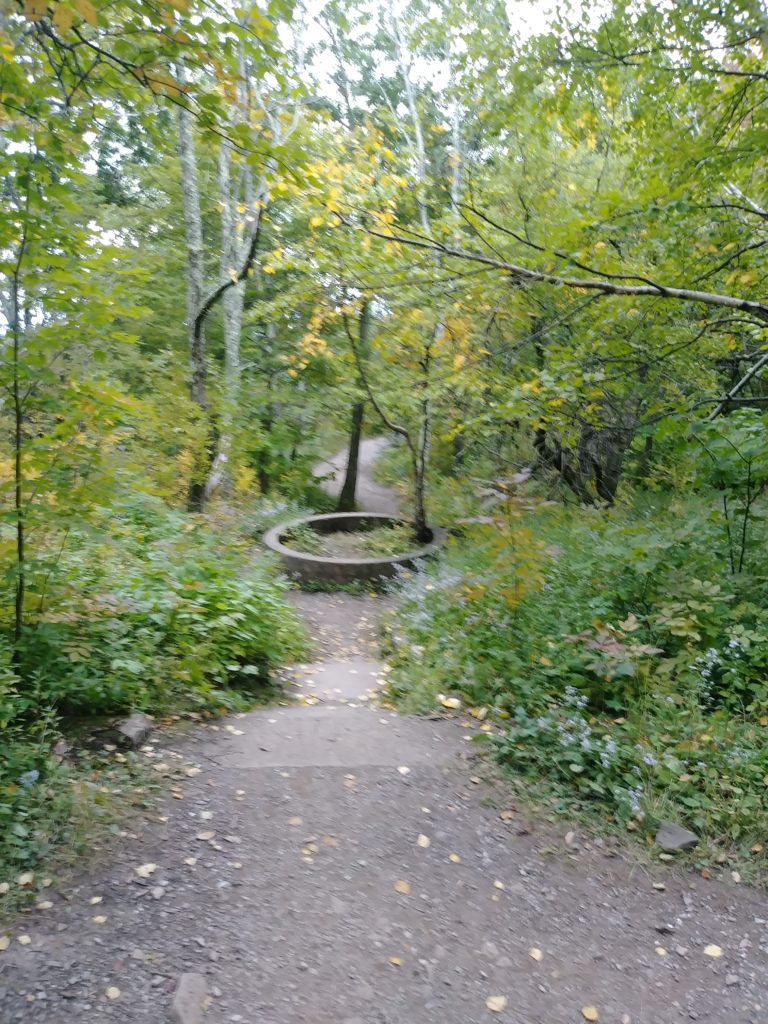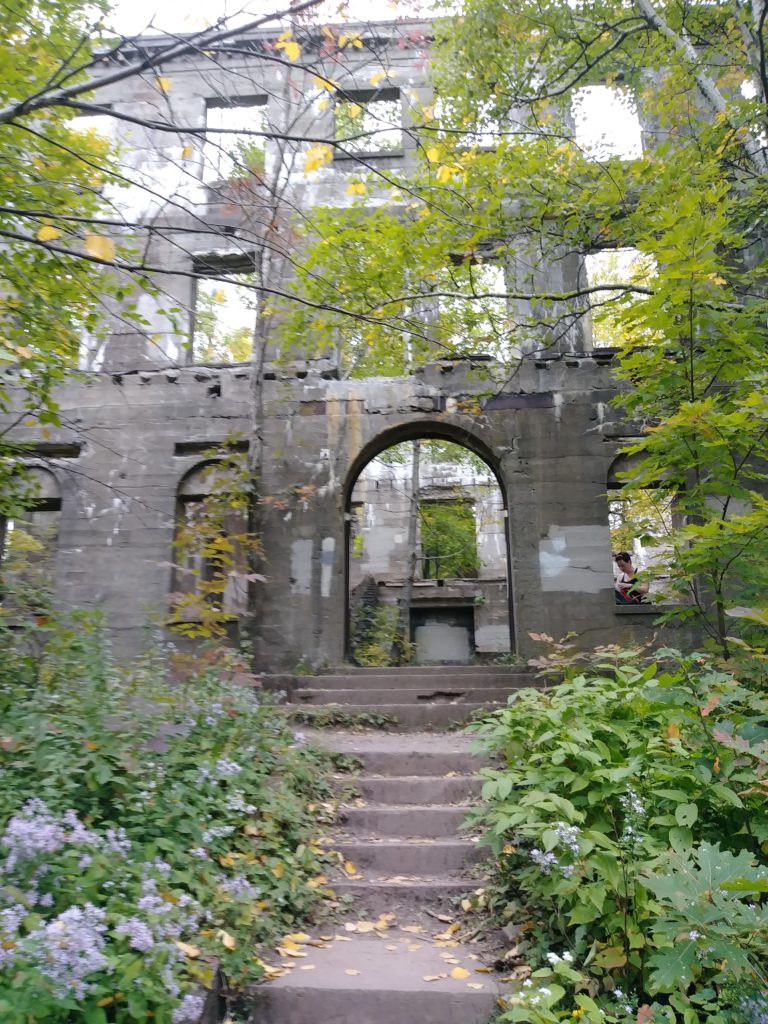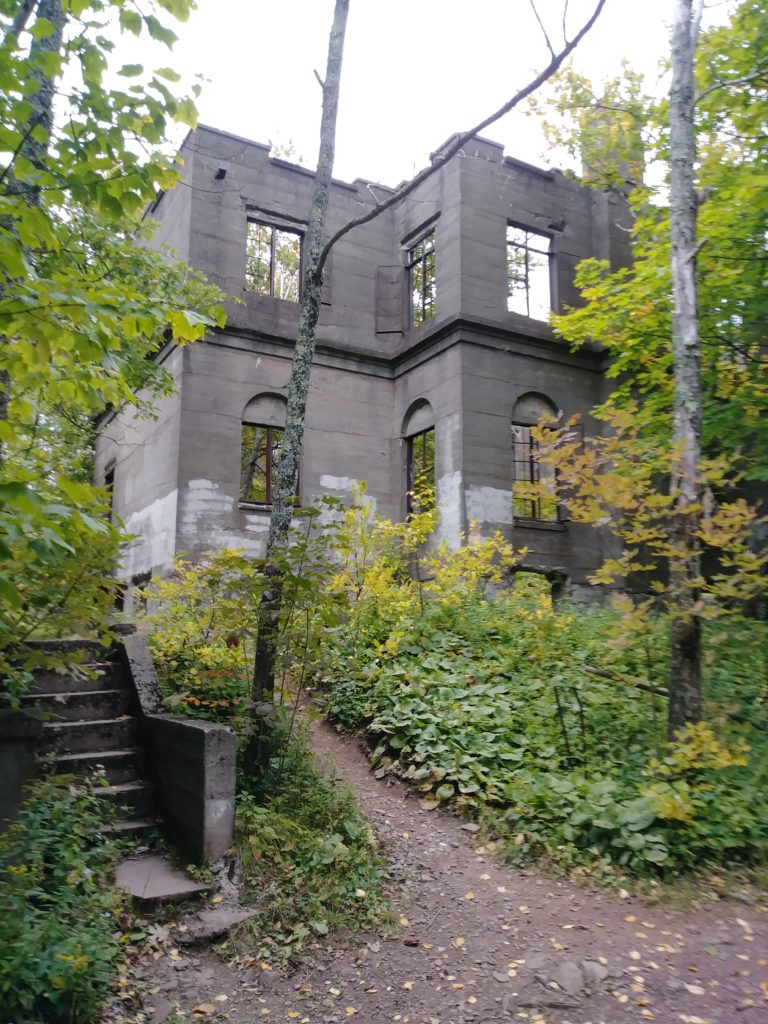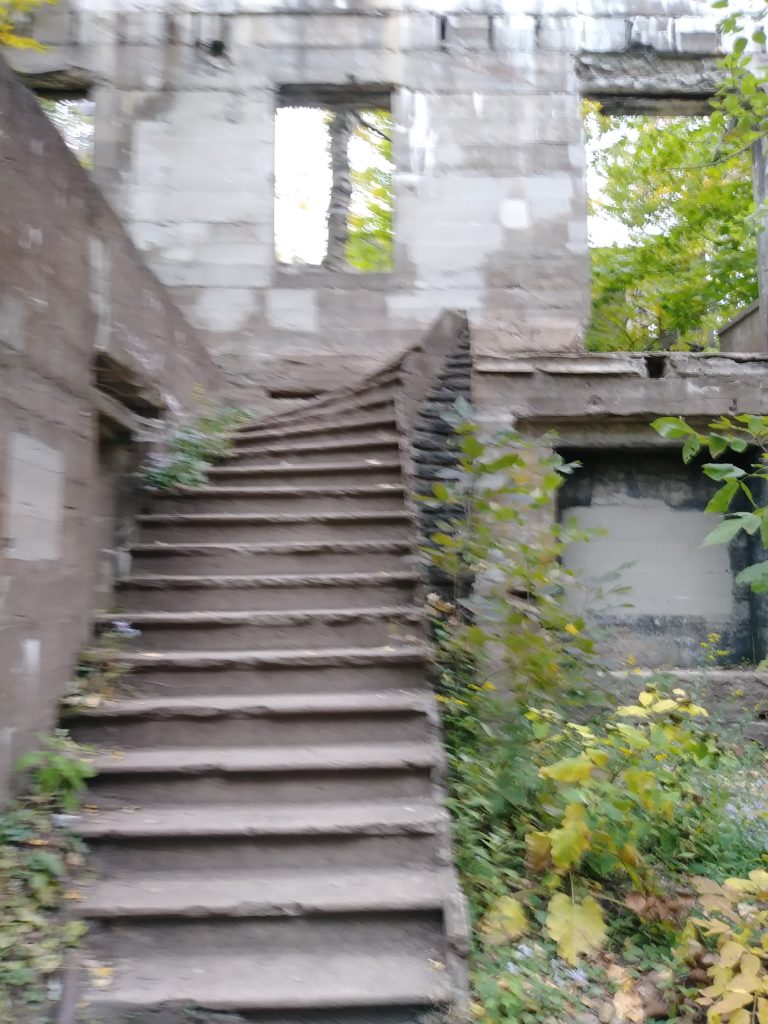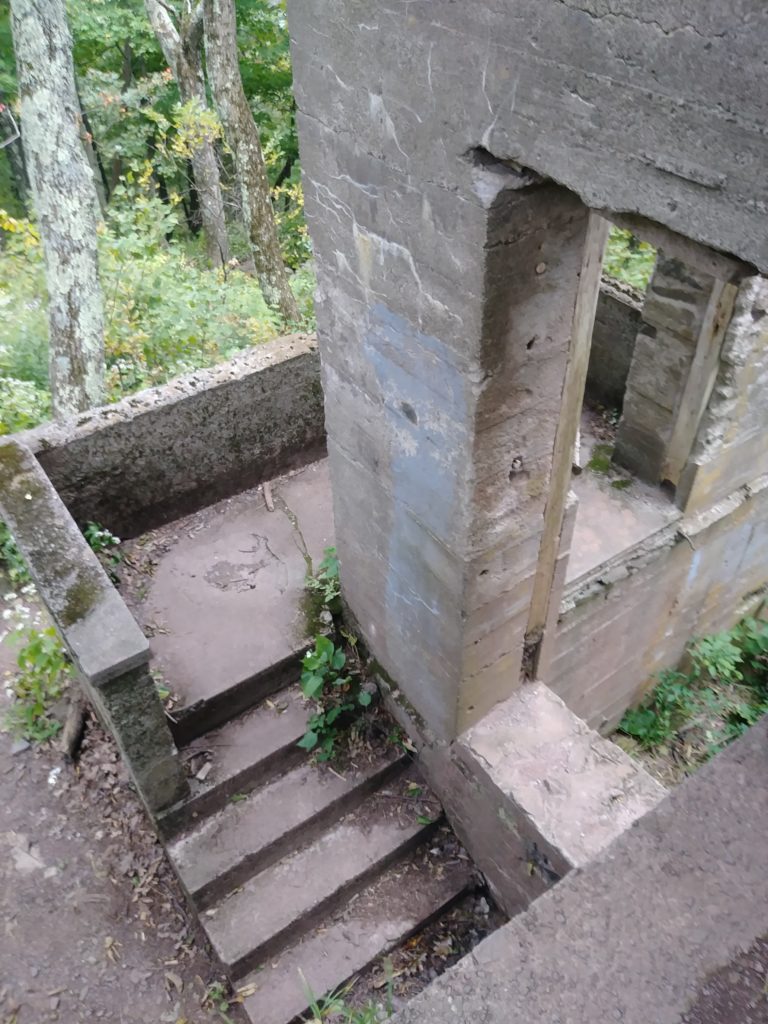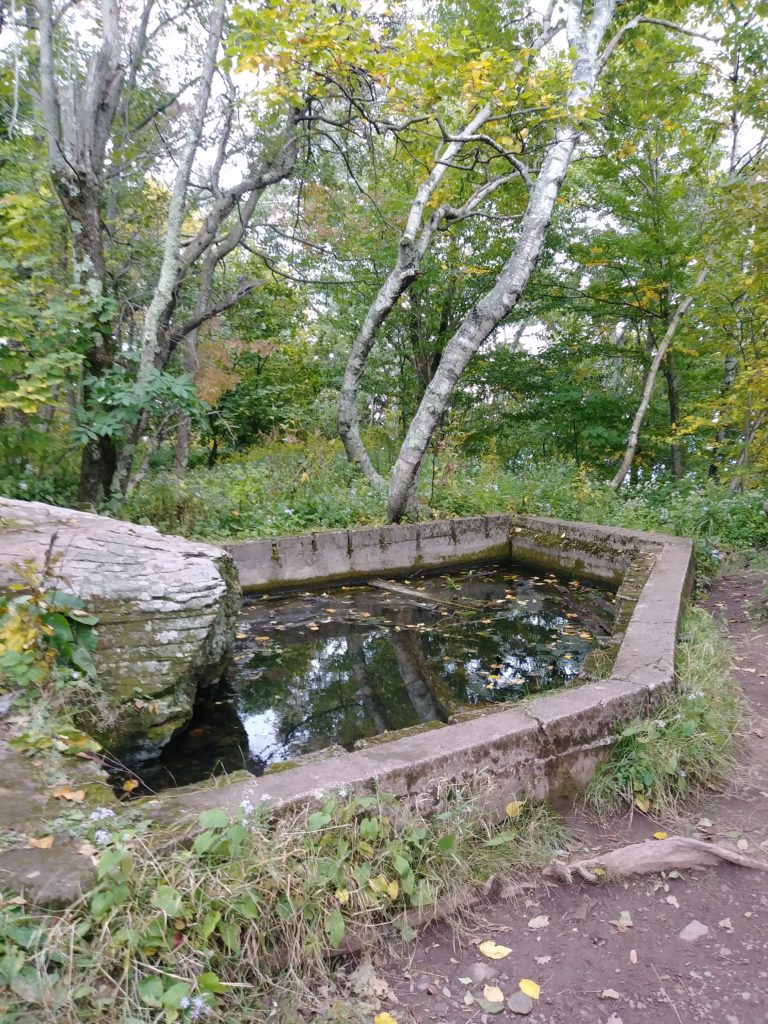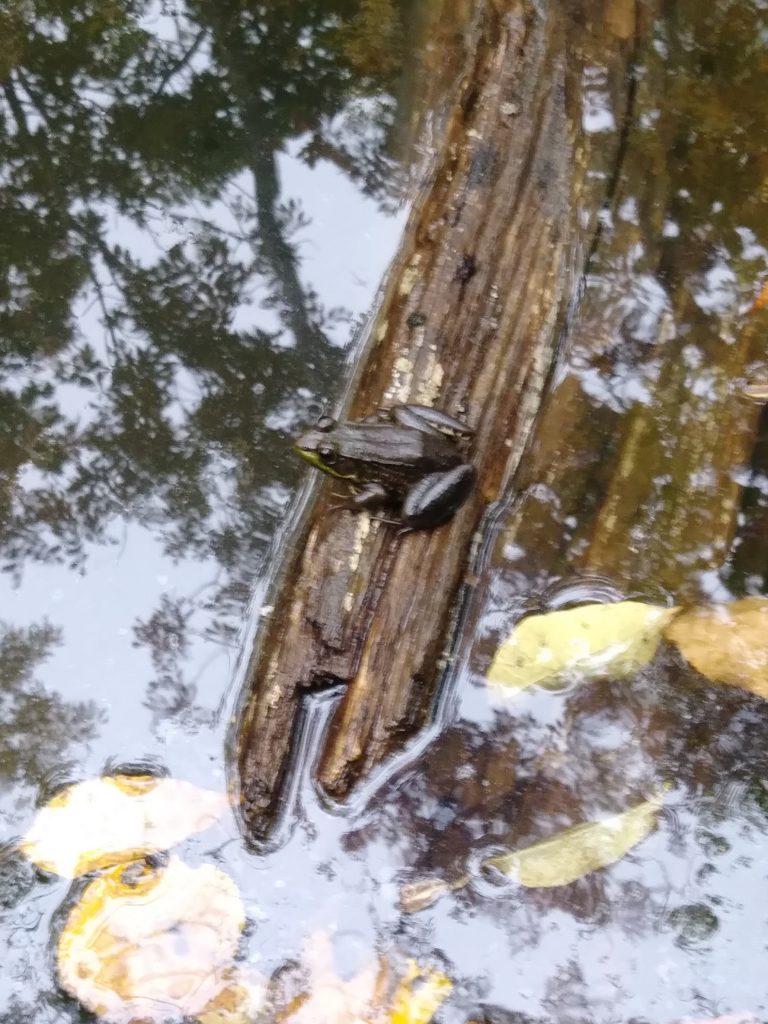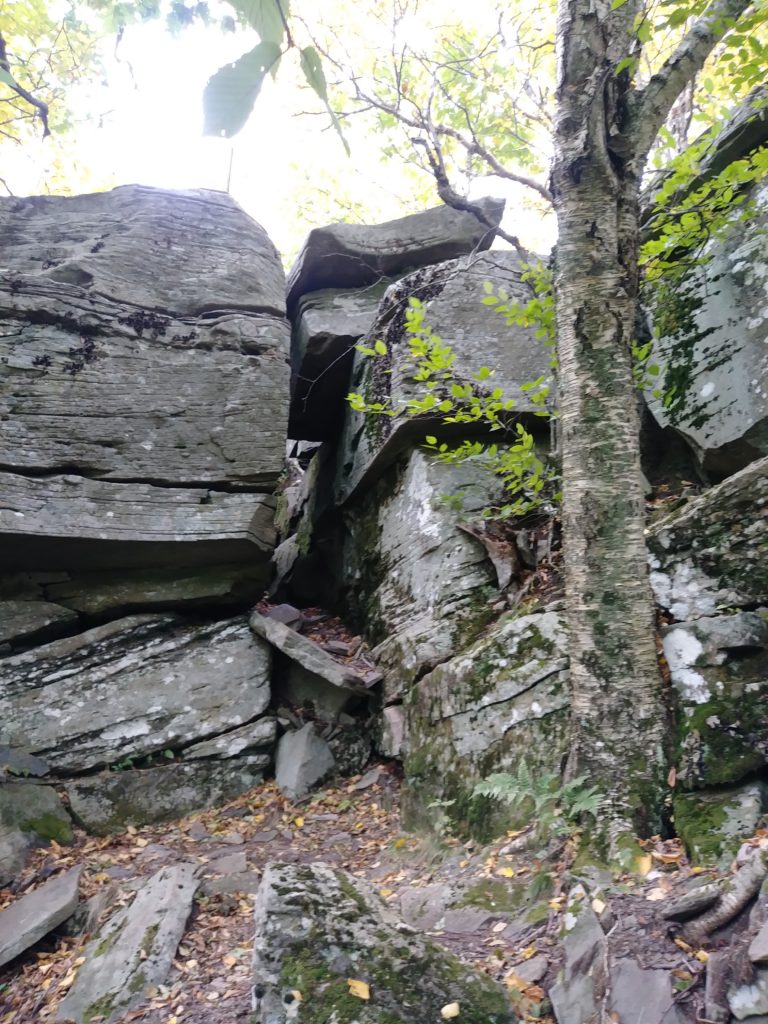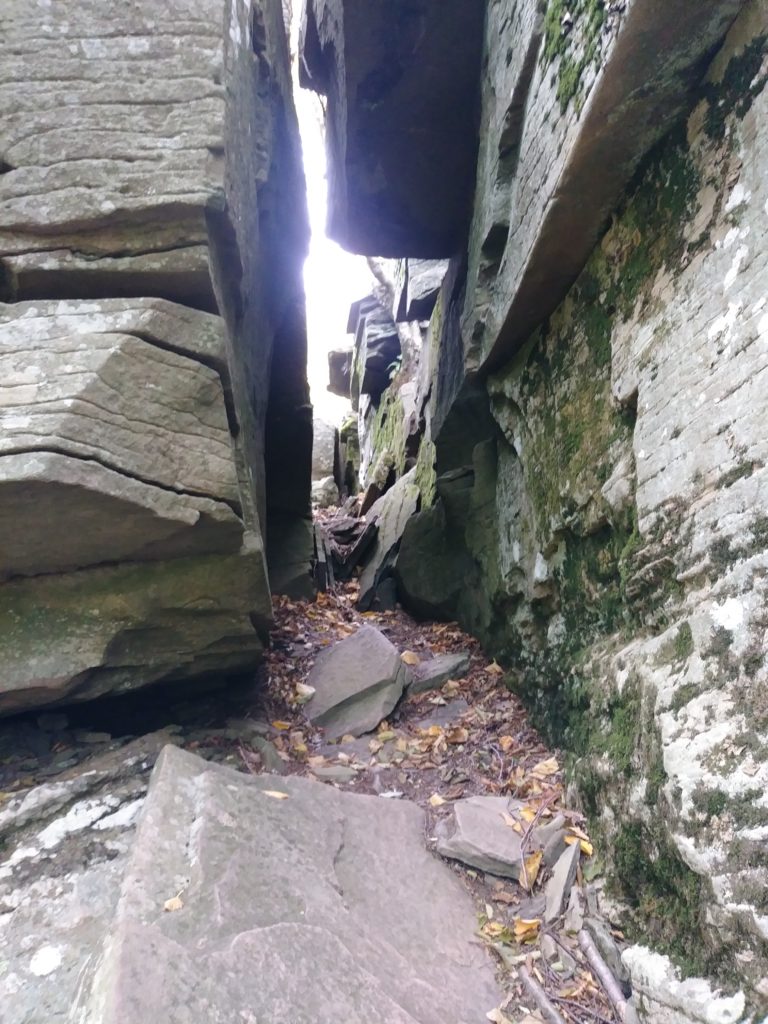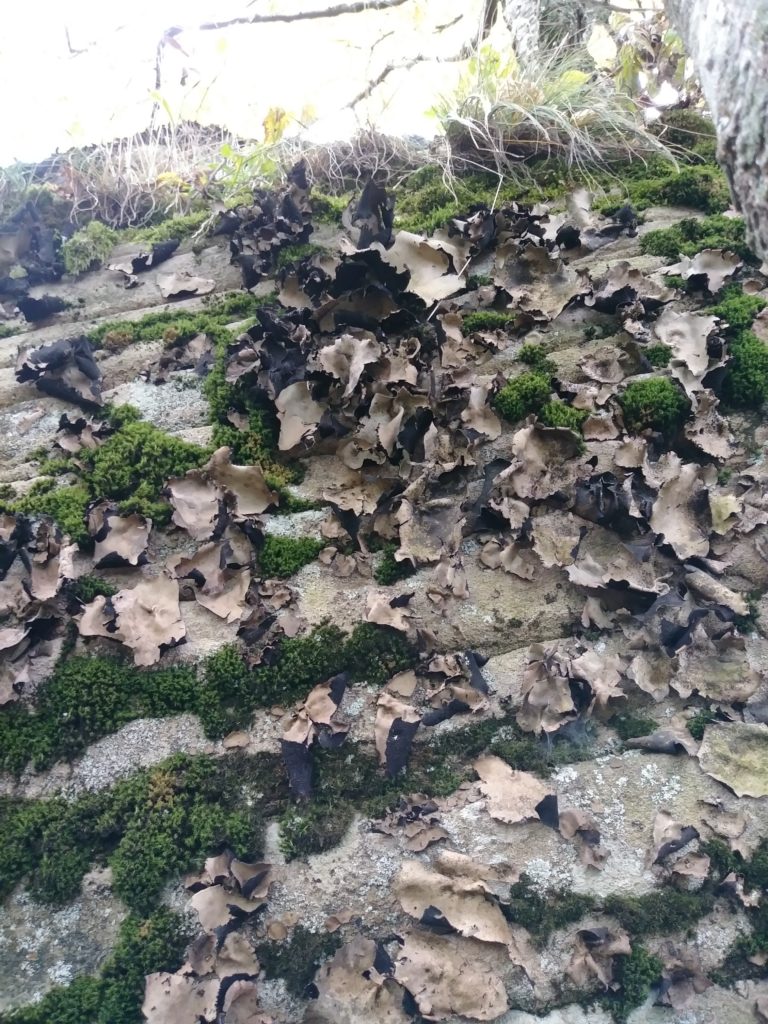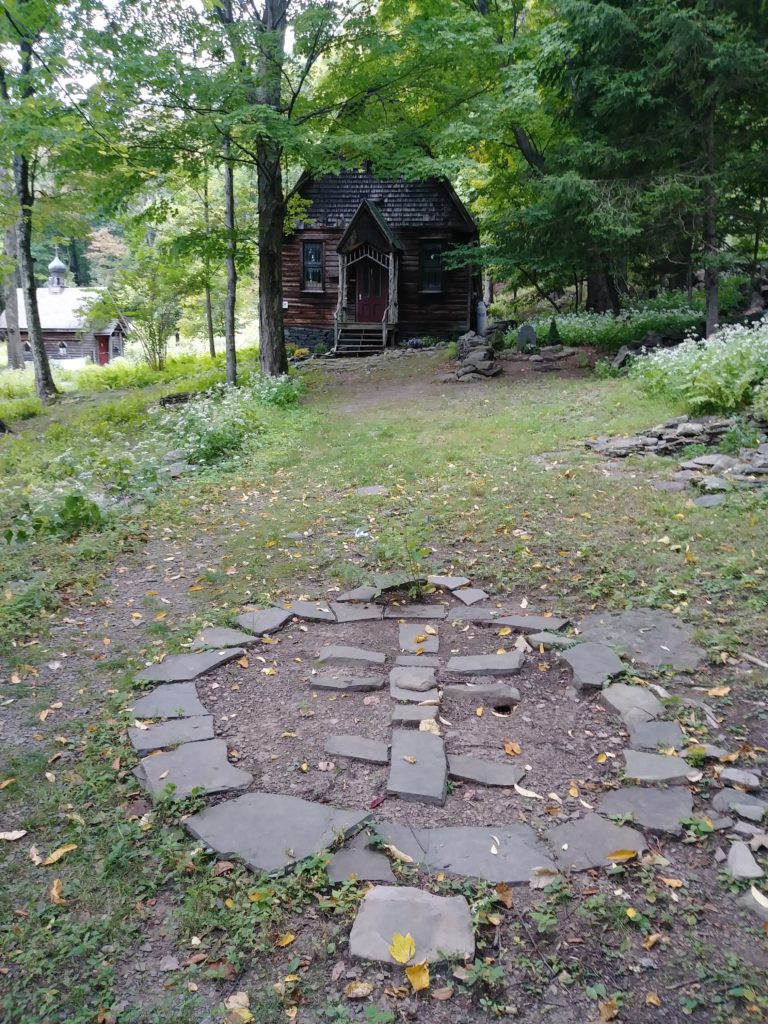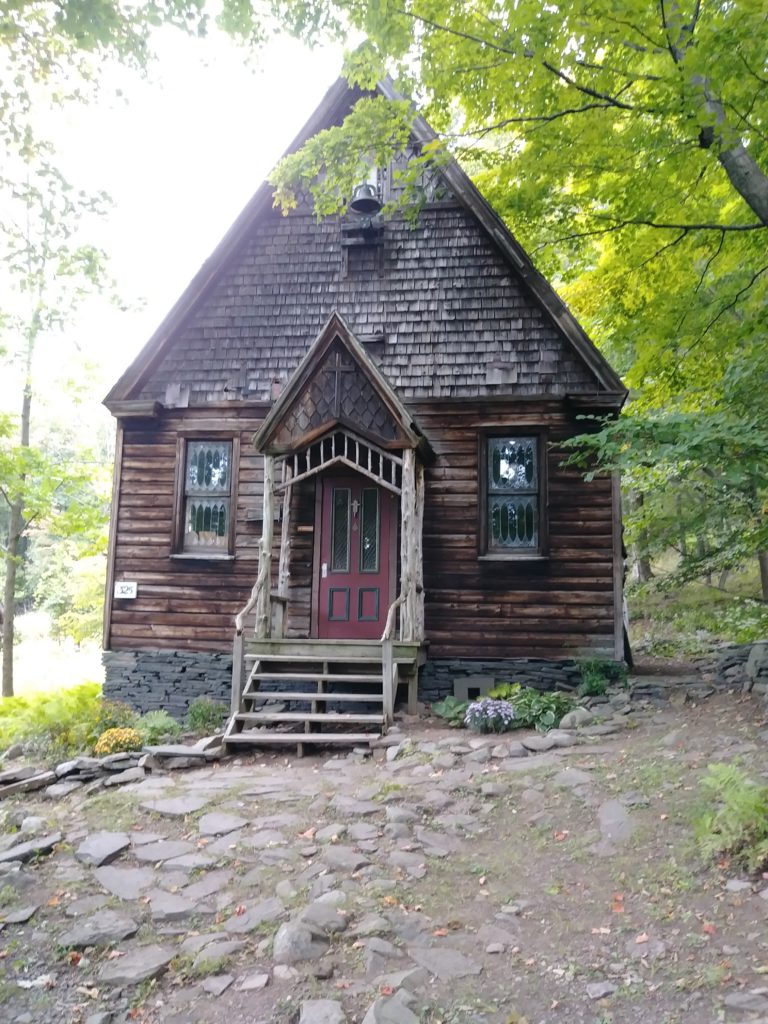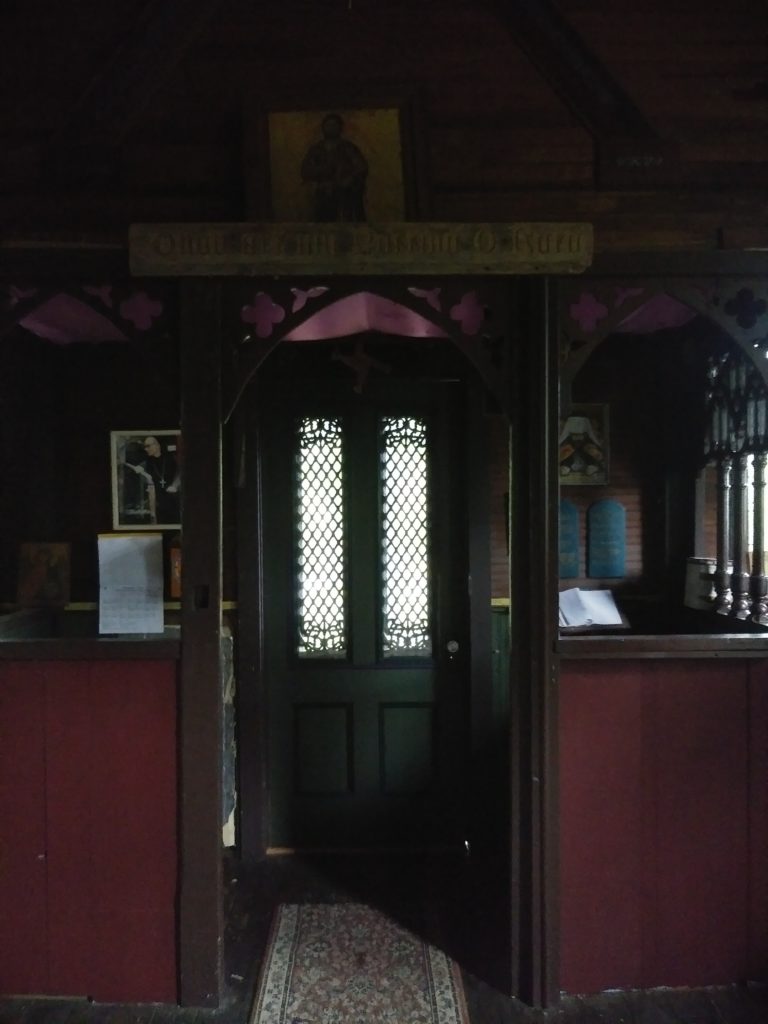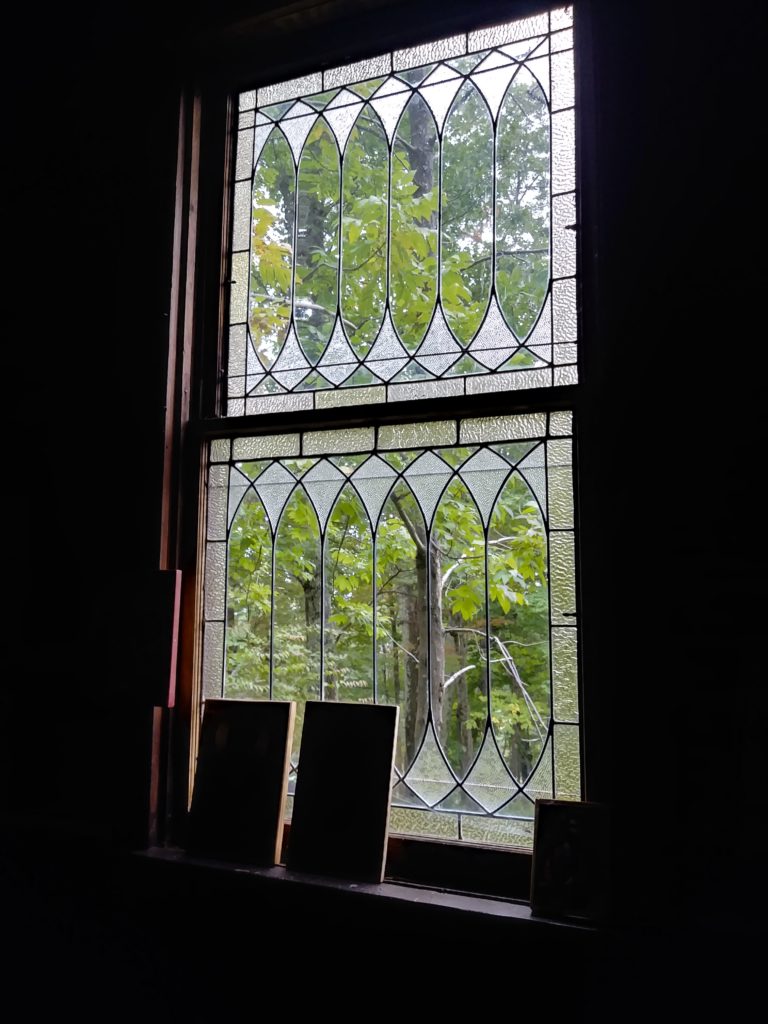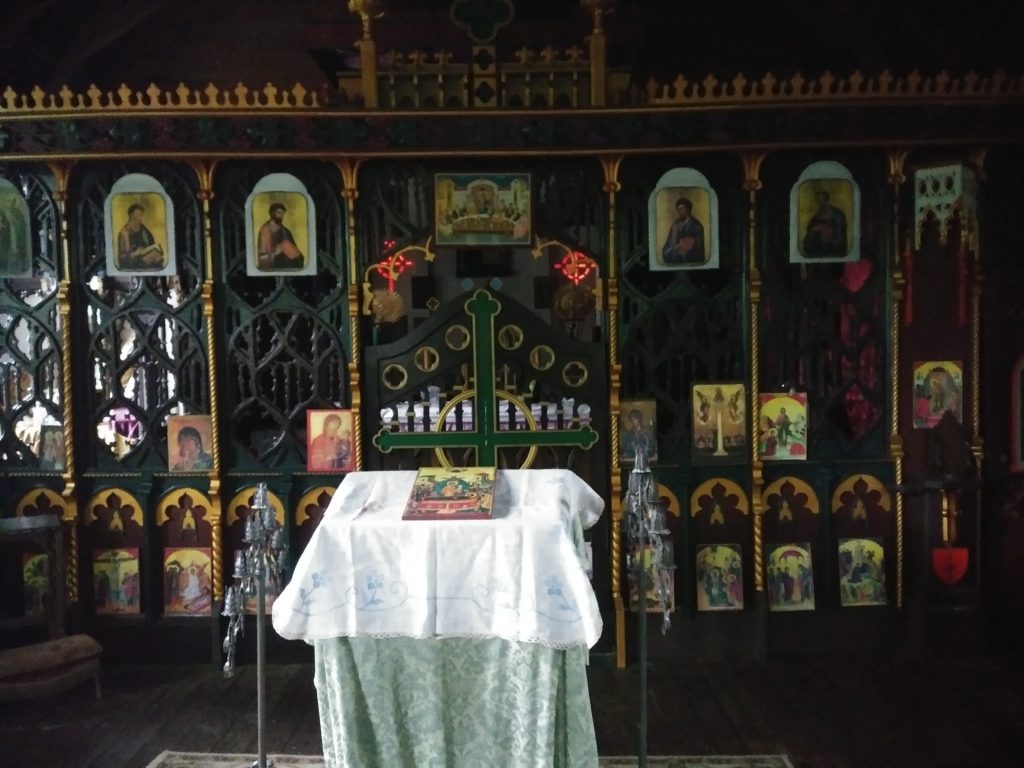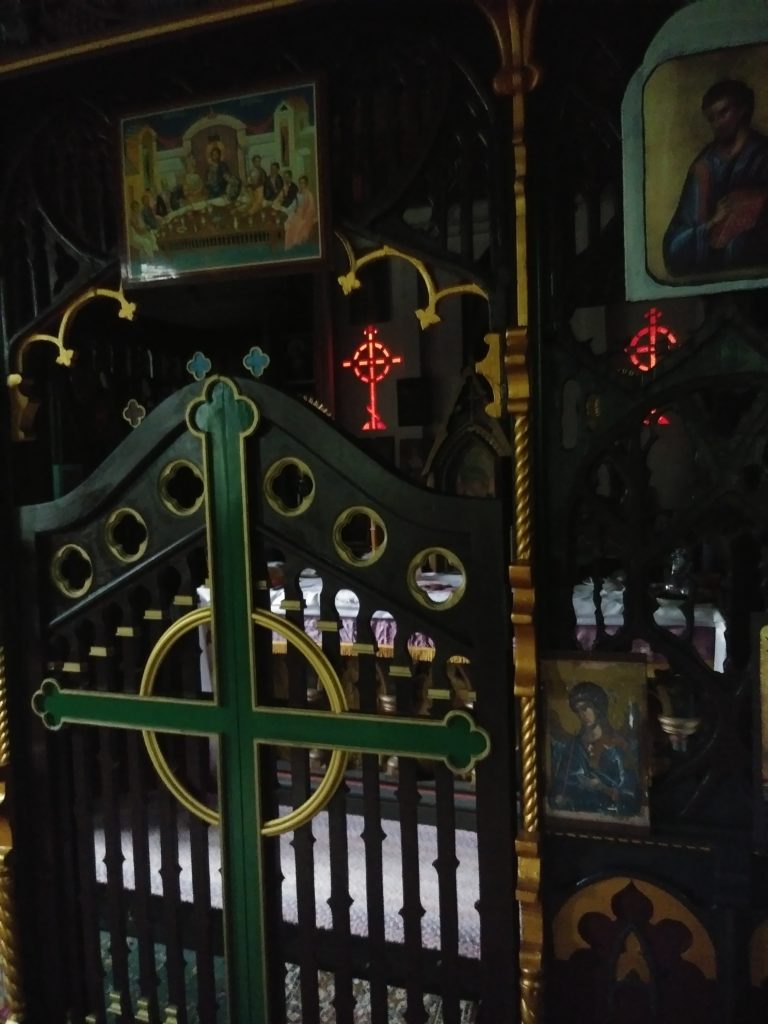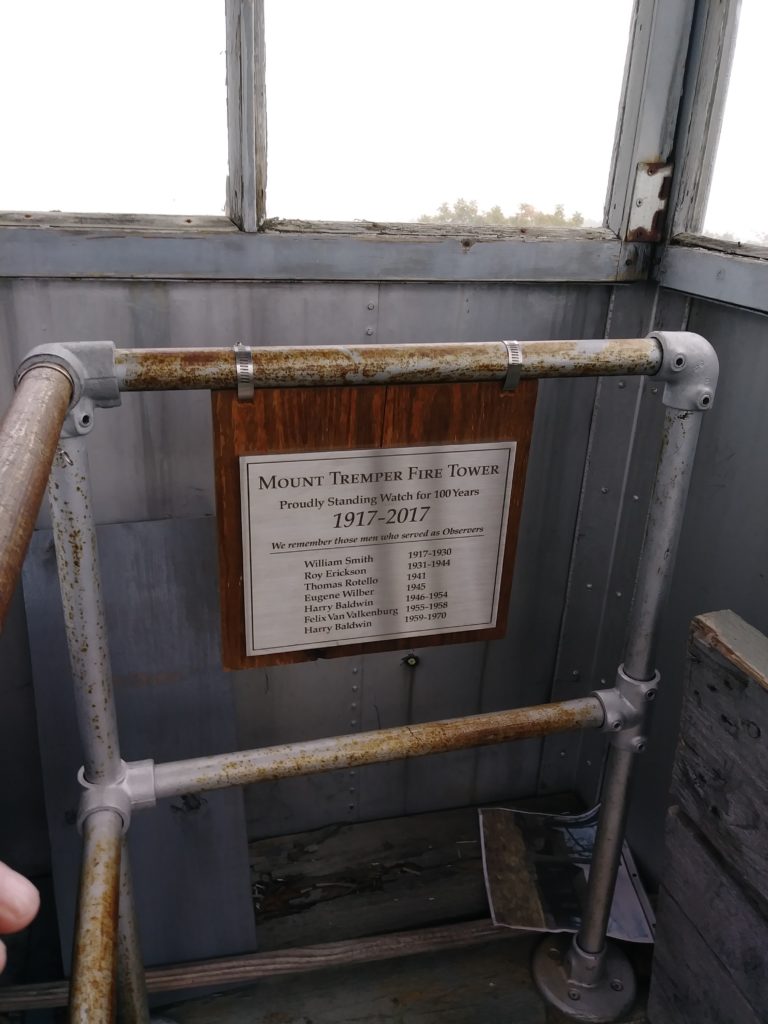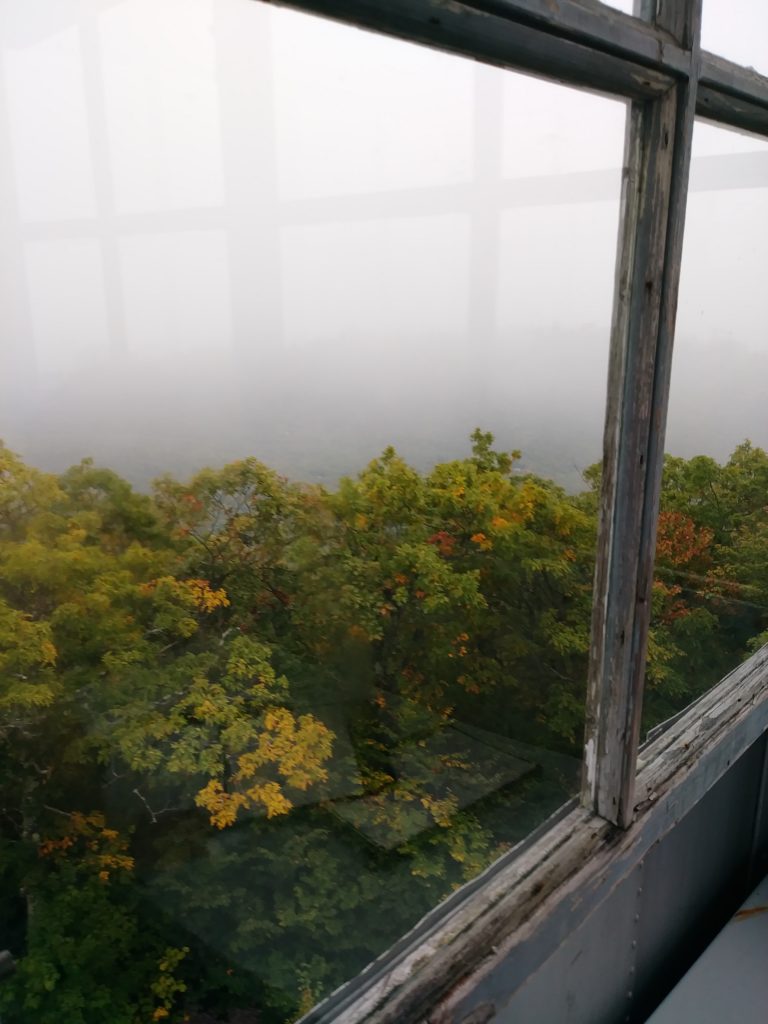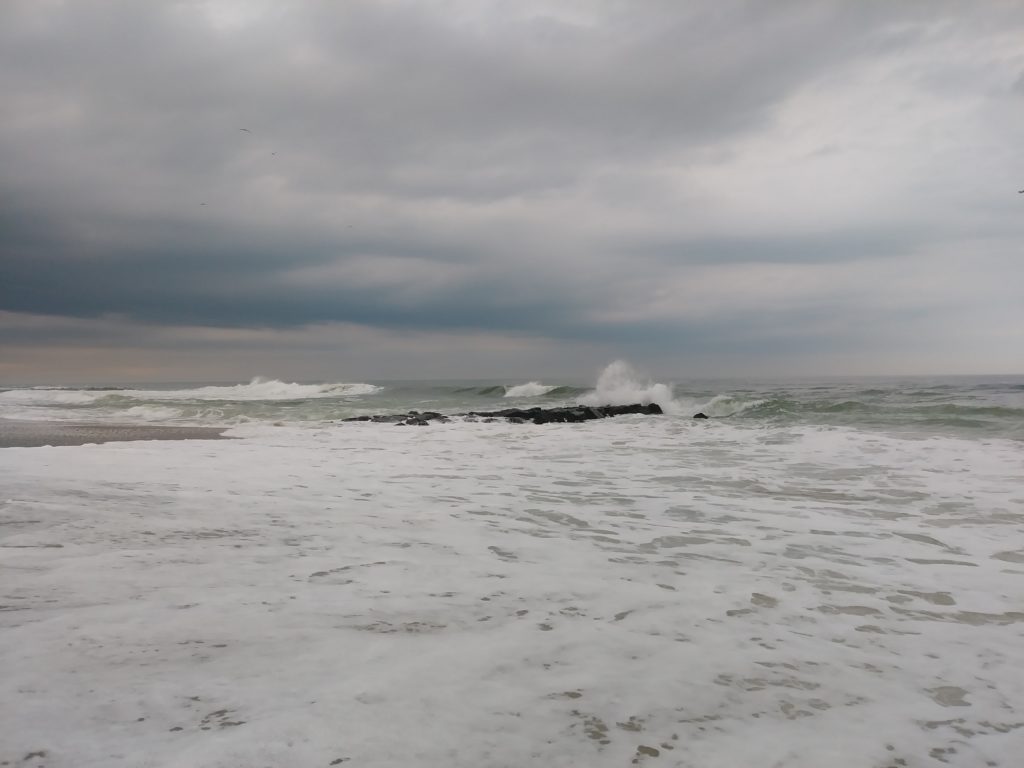Now, lovelies, you may have been wondering how I’ve occupied myself for the parts of the fall that followed the conclusion of the Great Trek of 2020 but preceded the beginning of my new (non-writing) employment.
Havoc and mayhem have been the watchwords, obviously. My days mostly started with a view rather like this:
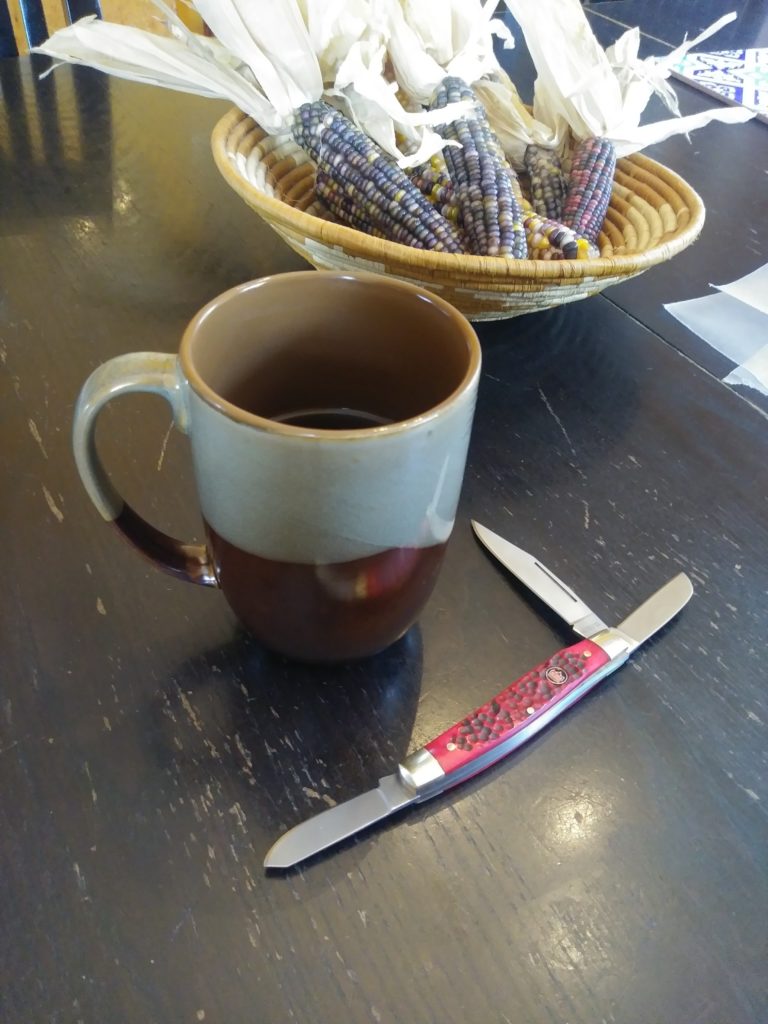
Tea, sharp blades…. Perfect recipe for all kinds of mischief.
Also, I went on some very lovely prowls, both urban and country, daytime and nighttime.
I even remembered to take a few pictures.
Springfield, NJ
The thing about New Jersey is that, smack in the midst of the most prosaic suburbia imaginable, there’s all manner of interesting history lurking.
I went on a perambulation about the most suburban suburbia I have ever encountered, and all the while was, in fact, treading the sites of skirmishes and battles from the American War for Independence. I should’ve worn my tricornered hat.
We stopped at the Cannonball House (built circa 1741)- a home known for the cannonball embedded in its siding during the Battle of Springfield in 1780. A sign outside proclaimed:
“Here, June 23rd, 1780, 1500 Americans, under Greene and Dayton, were attacked by 5000 British and Hessians under Clinton and Knyphausen en route to capture stores at Morristown. The British burned Springfield, but were defeated.”
The house was closed to visitors, this being a plague year and all, but a member of the historical society was out tending to the back garden and happily explained the history of the house. (The cannonball fell out of the siding when some repairs were made; a replica hangs on the outside of the house, and the original is displayed inside.)
We proceeded to the First Presbyterian Church of Springfield. The congregation formed in 1745; their church was burned by the British in the Battle of Springfield, and the current building dates from 1791. Washington may have stayed over in the parsonage.
On the lawn in front of the church is the smallest state park, measuring 5 feet by 5 feet, on which is a statue of a soldier of the Continental Army.
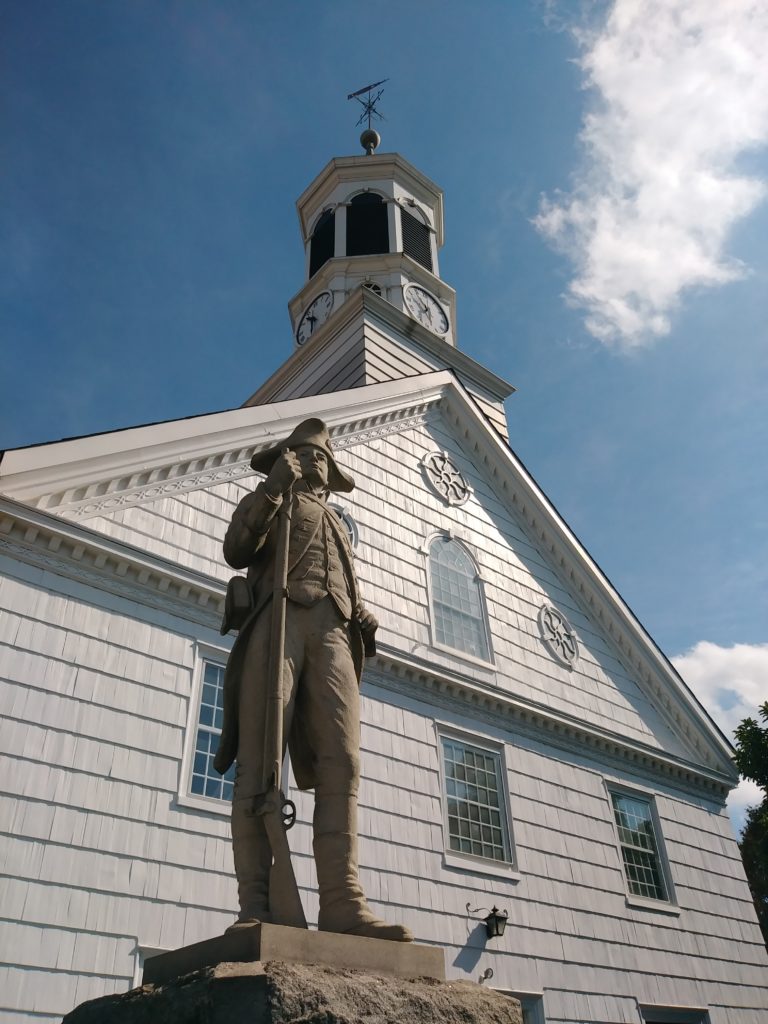
The sign at the statue reads:
“The first British advance was stayed at the bridge east of the village , June 7, 1780. The Battle of Springfield was fought June 23rd. The Americans under General Greene on that day near the stream west of the church checked the enemy, who in their retreat burned the church and village. From this church Parson Caldwell took psalm-books during the fight and flung them to the Americans for wadding, crying, ‘Put Watts into’em, boys.”
Imagine that! This is the place where the famous story about the pastor and the psalm books took place!
The church cemetery across the street contains graves of those who fought in the French and Indian War, the War for Independence, and the War of 1812. In a jarring contrast, the lot beside the cemetery is being excavated for what looks like an apartment complex, within just a few feet of some of the tombstones.
Ah, New Jersey.
Pyramid Mountain Natural Historic Area
This was an interesting hike out in Montville Township, NJ; Pyramid Mountain is overseen by the Morris County Park Commission.
We went to see the erratic boulders.
No. Contrary to what you might suppose, these are not boulders that behave erratically. Rather, they were deposited by glaciers. Because, you know, if you’re a glacier, you’ve got nothing much better to do than pick up rocks and put them back down again.
Actually, that sounds remarkably like some of my Sundays.
In all seriousness, the term comes from the Latin errare, which means “to wander.”
Wandering rocks.
That might explain why some of them were so hard to find.
Anyways.
The trails seem to have been cut and marked by a rabid pack of monkeys armed with a box of Crayolas. Random stretches of trail were assigned equally random colors. You’d be on the white trail. Then it was the blue trail. Suddenly you were at a fork to the white/yellow, blue/white/yellow, and yellow/blue stripe trails. Oh, and if you took the yellow/blue stripe, it was sure to magically morph into the orange trail half a mile later… never mind that the orange trail had ended two miles ago.
My word. I’d thought it was impossible for me to misread a map and take a wrong turn. Those Crayola-wielding monkeys sure showed me.
My group was not the only one that got all turned around. We circled past a group of generally college-aged gentlemen (whose conversation amongst themselves included the profound query: “Wait, I forget- is the coronavirus a virus or a bacteria?”) several times. By our third encounter, the whole thing bore a striking similarity to a bad comedy routine.
The highlight of Pyramid Mountain is Tripod Rock, supposedly. It’s one of the aforementioned glacial erratics. The park website describes it as “a 180-ton boulder balanced on three smaller boulders deposited by the Wisconsin Glacier over 18,000 years ago.”
The formation did not much resemble a tripod. There was a whole mess of Jersey suburbanites milling about the base. They all had a collective fit when I climbed up the rock.
It kind of made me miss Wyoming.
Whale Rock and Bear Rock were unmarked, but bear enough resemblance to their namesakes to be identifiable, particularly Whale Rock.
It’s an okay place to hike- some pretty rock oucroppings, a decent view over the reservoir, and lots of trees. You just need to filter out the road noise and the other human beings clogging the trails.
However, the actual points of interest on this hike were the fungi, which occurred in a multitude of striking colors. I had never seen a purple or a green mushroom before. Do you suppose these glow in the dark? Or perhaps are radioactive?
Certainly they don’t seem terribly edible.
The Catskills
Overlook Mountain
Well, the Catskills themselves are all right.
Our first hike on our weekend trip here was in Woodstock, NY.
Look, it may have been a cool place in the 1960s, but this is 2020, darlings, and the town is just a tourist disaster, with ticket-happy parking police. I highly recommend skipping this town and spending your vacation somewhere less pretentious and snitty, like Phoenicia.
That said, the hike up Overlook Mountain wasn’t terribly difficult and was reasonably pretty. There were droves of other hikers, but I suppose that’s our own fault for going on a Saturday afternoon.
Our chosen destination was the fire watchtower at the top of Overlook Mountain.
Indeed, as you will observe, there is a preserved fire tower (no longer in active use) at the top, about 3,100 feet. It was built in 1950 and is 60 feet tall. The view is nice, albeit somewhat windy. We couldn’t access the birdsnest enclosure at the top, since it was padlocked shut.
I’d left my boltcutters at home. Damn it. I always forget to pack something.
Whilst the fire tower is interesting, the real star of the hike was the ruins of a hotel; in fact, the trail we climbed constituted the old carriage road that accessed it.
The ruins of Overlook Mountain House are at 2,900 feet. It has an interesting history- interesting enough to earn it an Atlas Obscura post, here.
The first luxury hotel in this location was built in 1833 and closed after a few years. The second (built in 1871) was a 300 room hotel that burned in 1875. It was rebuilt in 1878 and burned yet again in 1921.
Third time’s the charm- or at least the time you use construction materials that’re somewhat less flammable. That explains all the concrete that makes up the bones of this place. The rebuild was never completed for financial reasons, and the owner sold out to New York state in 1940.
The ruins burned AGAIN in 1970.
But, you know- concrete.
The ruins are a great place to explore in the fall, and the nearer you are to Halloween, the better. I found it fascinating how the trees had come back to live inside the building. Some of the windows remain, the smashed glass on the ground but the frames still happy to swing at a touch. There’s a bathtub. There’s a staircase that breaks off in midair. You can walk at first-floor level on top of what remains of the interior walls.
Look, it might have been a terrible place to try to put a hotel, but it’s the perfect spot for some haunted ruins.
Overlook Mountain is home to large populations of timber rattlesnakes (Crotalus horridus– which translates roughly as “dreadful rattle”). They like to hang out on the rocks. I did not see any, possibly due to the time of year. Apparently these snakes can live for upwards of fifty years (most don’t, tapping out in their early teens). Did you know they can climb trees?
Yuck.
Near the trailhead, on Webster Rd, right next door to the Buddhist monastery (there is a Buddhist monastery every ten miles in the Catskills), is a charming little Western Orthodox church, whose doors were unlocked.
It was delightfully spooky.
Seriously. I’m surprised we walked back out alive. It’s dark, all wood, and built in 1891. I adored it.
Back in the day, its pastor was Fr. Francis, “the hippie priest.” The church is also allegedly home to a Marian weeping icon; I did not know this until some time after my visit, else I’d’ve looked for it and taken you lovelies a picture.
Weeping icons apparently shed actual tears.
Either that or there’s some water condensation and weed going on. It’s Woodstock, after all- lots of senior citizens trying to recapture a youth that wasn’t half as cool or rebellious as they like to think it was. So flip a coin on that weeping icon business.
Tremper Mountain
Our second hike was up Mount Tremper, a mountain in the Catskills near Phoenicia, NY, which is also home to a fire tower. I found this a much more enjoyable, though more strenuous, hike than Overlook. The trail up Tremper is part of the Long Path (a hybrid trail with an interesting history that runs from the GW bridge’s Fort Lee, NJ side to somewhere past Albany). On the ascent, one passes two shelters for Long Pathers, as well as a pretty spring.
Sadly, it was a cloudy day, and there wasn’t much to be seen from the fire tower. However, unlike the Overlook tower, the hatch into the enclosed nest at the top was unlocked. The tower dates to 1917 and is 47 feet tall; the elevation here is 2,700 feet.
Any disappointment we experienced over the clouded view at the top was obliterated by the discovery of great fudge and ice cream in Phoenicia’s rather tiny downtown. Tiny, but I’d go back to The Ice Cream Station and their fly fishing ice cream any time.
Also, the Phoenicia Diner cooks up some tasty local trout.
Now, rather than just talking to the trees, on this trip I packed my forest tree field guide into my bugout bag and identified some of my leafy friends’ species.
Some.
Clearly I need more practice at this. A lot of leaves all look the same.
….. Perhaps they all were the same.
Right, well. Anyways. I know what hemlock trees look like from previous experience. I stumbled into a soothing stand of them on the hike up Mount Tremper. They, like pine trees, have a way of making the world go silent when they grow together in a community.
To finally experience the joy of successfully identifying a tree, I got out my field guide, and learned a surprising fact: hemlock trees are edible! Native Americans and lumberjacks made tasty tea out of its needles!
Those of you with a classical education will find this surprising, given Socrates’ terminal experience with hemlock.

The cause of this confusion is that the hemlock plant known to the ancient Greeks had nothing to do with the hemlock trees growing in eastern North America. Conium maculatum is a member of the parsley family. Tsuga canadensis (the eastern hemlock, Canadian hemlock, eastern hemlock-spruce, or pruche du Canada) is a delightful evergreen tree that enjoys riparian locations and is a member of the pine family.
So there.
I have enjoyed several cups of this tasty tea (it tastes like Christmas in a tea mug!) and can vouch for its nontoxicity.
The Ocean
In the interests of symmetry, I paid a visit to the Atlantic Ocean. I went to Ocean Grove, NJ, which was founded in 1869 to be “God’s one square mile of the Jersey shore,” back in the days when camp meetings were a raging phenomenon in the USA. I guess the rest of the Jersey shore belongs to someone else.
The town is chock full of extremely picturesque, grand Victorian houses. It has a boardwalk that’s been rebuilt since Hurricane Sandy, a nice bakery on Main Street that makes a phenomenal chai, two good ice cream parlors, and free parking- an anomaly on the Jersey Shore. A striking landmark is the Great Auditorium, still in use- the camp meeting association still owns Ocean Grove and is active every summer. Folks go live in tents behind the auditorium and all that. It’s quite something, when there isn’t a plague on.
In keeping with its Methodist culture, it’s a dry town. No worries, though- you can just walk a mile north to Asbury Park, a comparative den of iniquity that certainly has enough bars and booze for both towns. Of interest here is the Convention Hall, a great example of 1920s architecture and a good place to catch a live show and dance in a circle pit, pre-plague. I saw The Interrupters play there a couple of years ago.
I love the beach on cloudy days.
I really love the Jersey Shore when it isn’t crawling with people.
